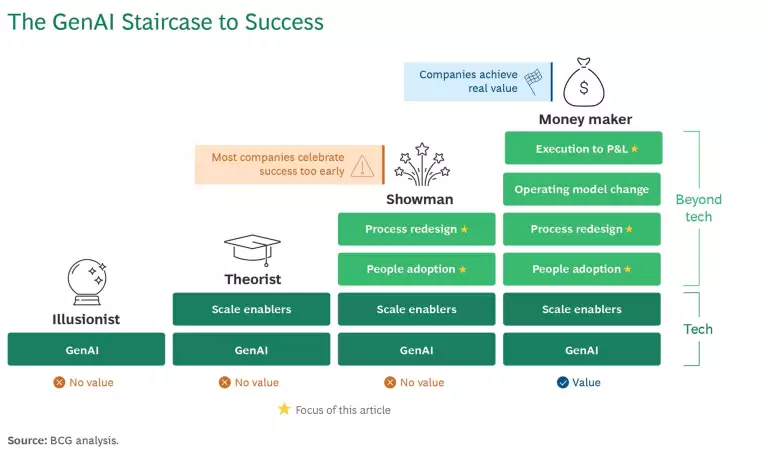For automotive and mobility companies , unlocking the full potential of traditional and generative artificial intelligence (GenAI)—particularly in driving cost and efficiency—has become a strategic, even existential, challenge. After years of development, this technology is ready to be deployed. Companies that do not embed these tools and solutions into their core business operations to deliver measurable outcomes risk falling far behind their peers and below market expectations.
There is reason for optimism, however, as industry leaders are already taking bold action to capture value through real-world, at-scale applications of AI . Success stories from GM, BMW, and other companies highlight the opportunities for turning vision into value.
The Key Elements for Automotive and Mobility Players
To emerge as industry leaders, automotive and mobility companies must harness AI and GenAI to empower teams, reimagine processes, and strategically align technology implementation with value- and cost-focused P&L objectives. This effort entails transitioning GenAI from an experimental tool with theoretical value to a proven driver of profitability. The urgency to leverage AI and GenAI to create lasting value in the automotive and mobility industry has never been greater, driven by rising pressures such as the shift to electric vehicles, evolving trade policies, and significant advances in other industries.

Based on insights from more than 350 projects across industries, BCG identified a GenAI stairway consisting of four stages that organizations must ascend to turn the technology’s potential value into tangible economic impact. (See the exhibit.) Following the stairway principles, our clients’ AI transformations have realized cost reductions of 8% to 12% compared with the baseline. This gives companies the potential to achieve a return on investment of 10 to 15 times in less than three years.
In successful AI and GenAI transformations by automotive and mobility industry leaders, three key elements of the stairway stand out:
- People Adoption. Fostering adoption by users ensures seamless integration of tools into daily work.
- Process Redesign. Redesigning processes allows automotive and mobility companies to extend AI’s capabilities beyond technology teams, embedding them in core functions such as manufacturing and product design.
- Execution to P&L. Linking execution to the P&L statement grounds progress in financial metrics, a critical focus for automotive and mobility companies as they grapple with increasingly tight margins. A structured, programmatic approach to effectively measuring and sustaining results is crucial to reinforcing these efforts.
Real-world examples highlight how leading automotive and mobility companies have addressed people adoption and process redesign to achieve impact. The challenge now lies in advancing execution to P&L to fully capture and sustain the value of AI-driven transformation across the automotive and mobility industry.
Subscribe to our Automotive Industry E-Alert.
People Adoption Ensures Integration into Daily Work
To strategically allocate effort and resources, leading organizations embrace the 10/20/70 principle when implementing AI and GenAI. Although algorithms (10% of the effort) and technology (20%) are vital components, organizations should devote the lion’s share of resources—70%—to people and process changes.
Investing in change management can double adoption rates, boosting them to 60% versus just 30% without such investment. And while designing a well-functioning technology tool is crucial, it is equally important to consider how users will adopt it and integrate it into existing workflows.
BMW has collaborated with BCG to assemble Knowledge Navigator, an internal AI-enabled, chat-based tool that facilitates context-aware research within internal documentation and data sources. This innovative tool provides faster, more convenient access to critical data across the organization, significantly enhancing the speed and accuracy of work across multiple platforms. For example, quality and procurement teams can easily retrieve specification data, technical standards, and supplier-specific information—eliminating the need for lengthy searches or reliance on colleagues.
A major challenge that the tool addresses involves the traceability and validity of information. The solution automatically references quotes, links to source files, and page numbers for easy validation or in-depth analysis. It also flags conflicting information and version discrepancies among data sources. By scaling this solution, BMW ensures seamless and consistent access to valuable insights across all teams, promoting the adoption of this tool as an essential organizational resource.
Achieving widespread adoption is fundamental to the success of any AI or GenAI implementation. When users across an organization embrace these tools and integrate them into their daily workflows, they unlock the tools’ potential for transformative impact. Introducing agent-based orchestration across different GenAI solutions can further boost adoption by simplifying usage and making the technology accessible on a mass scale. However, adoption alone is no guarantee that the tools will deliver their full value. Companies must thoughtfully redesign their processes and workflows to enable the seamless integration of AI and GenAI capabilities into core operations and to maximize their intended value.
Process Redesign Unlocks AI’s Full Capability Potential
To maximize the value that AI and GenAI tools create, automotive and mobility companies must redesign their processes so that they incorporate the full range of available capabilities. Companies that undertake holistic changes to processes and workflows report efficiency gains of up to 50%—benefits that would remain untapped in an AI or GenAI implementation that focused solely on technology.
In collaboration with BCG and Microsoft, General Motors’ Marketing and Data & Analytics teams rewired key processes to develop and implement an AI-powered audience selection engine. This tool synthesizes numerous first- and third-party data inputs to improve a marketer’s ability to define audiences and to design impactful campaigns. Developing and streaming this tool and its underlying data analytics platform required significant effort; Microsoft Azure’s data and analytics capabilities played a key role alongside BCG and GM teams. Early testing indicates that this engine consistently outperformed other models, enabling GM to optimize costs and data security.
A key element of this success involved reshaping workflows to bring supporting elements—such as data ingestion and audience creation—in-house, giving GM greater control over critical processes. In addition, closer collaboration between technology teams and business units ensured that the engine’s insights—such as particular customer segments’ propensity to purchase specific brands or vehicles—directly influenced the design and implementation of crucial marketing campaigns. These efforts have positioned GM to realize the full potential of its AI-powered marketing engine.
Another example is BMW’s work with BCG to introduce an AI-powered Tender Assistant to transform and streamline its tendering and request-for-proposal (RFP) processes. This advanced tool automatically drafts and adjusts tenders and RFPs to follow best practices, ensuring standardization and verifying the inclusion of necessary information. By using chat-based support and optimization, the assistant has reduced the number of iterations, enhanced quality, and streamlined collaboration between procurement and business teams. Redesigning their processes around tender support has unlocked these teams’ potential to improve time savings over the entire process by 50% without compromising quality.
A company cannot fully integrate an AI or GenAI tool into its core business operations until it redesigns existing processes to accommodate the new technology’s features and capabilities. But the integration journey does not end with modified workflows: companies must also directly link these new processes to tangible financial outcomes.
Execution to P&L Promotes Financial Value
At the outset of pursuing any AI or GenAI strategy, organizations must clearly define how efficiency gains will influence their P&L statement, and they must commit to tracking and measuring these gains. These gains can drive both top-line growth and bottom-line improvements. However, tracking success and managing the implementation of AI solutions are complicated and time-consuming operations. To address this, organizations should establish a dedicated AI transformation office empowered by leadership to oversee implementation and ensure the achievement of predefined financial targets.
Within the automotive and mobility industry, examples of companies that have successfully committed to an end-to-end approach and linked their AI-driven transformations directly to measurable P&L outcomes remain scarce. Nevertheless, our experience driving transformations in other industries demonstrates that becoming an AI money maker is not only achievable but soon will be essential for survival.
For example, a leading chemicals company recently collaborated with BCG to execute a transformative, end-to-end AI journey, using a structured and programmatic approach to maximize impact. The initiative incorporated rigorous value tracking to ensure measurable financial results. The company began by systematically assessing AI opportunities across its processes and identifying tools that would generate the greatest value while complementing one another to amplify their collective impact. Key solutions implemented included an automated tender assistant, an RFP response automation tool, and an HR service chatbot—each designed to address specific challenges and deliver quantifiable outcomes.
To ensure success, the chemicals company set clear, high-level savings targets for every tool, based on the tool’s projected value over a defined time horizon. Importantly, the company continuously monitored the actual savings delivered by each tool, assessing its performance against expectations. By adopting a structured, programmatic approach and diligently tracking results against these predefined objectives, the company was able to unlock the full potential of its AI investments and maximize their impact.
Although some automotive and mobility players may trail leaders in other industries, the gap is measured in months, not years, given the early stage of AI and GenAI adoption. Now is the time to establish a clear plan to close this gap within the next one to two years, unlocking the full potential of AI-driven value creation and securing a competitive edge in a rapidly changing industry.
Deriving full value from AI and GenAI is no simple feat—but leading companies are moving from potential to payoff today. For automotive and mobility companies, the ability to significantly reduce costs, enhance operational efficiencies, and develop new revenue sources could materially alter the industry’s competitive landscape. Beyond technical implementation, success demands strategic design choices that foster adoption, thoughtful process reengineering, and an unwavering focus on clear savings targets. Activist program management is essential to ensure execution. The journey may be complex, but automotive and mobility companies that embrace these principles stand to achieve substantial cost savings and build lasting competitive advantage, ultimately emerging as leaders in a rapidly changing industry.











